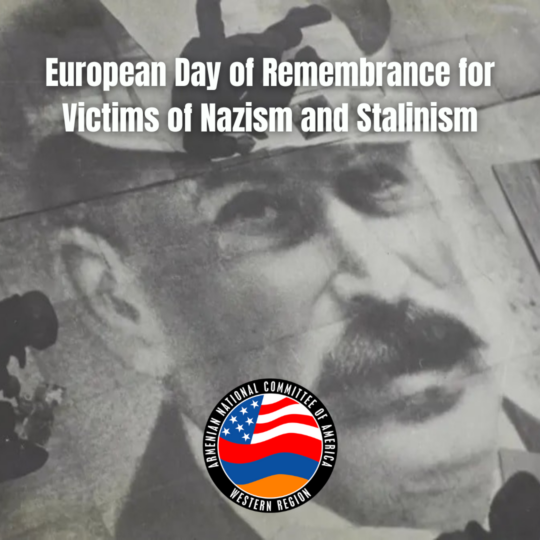
By: Ellin Manoukian, ANCA-WR Summer Intern
On European Day of Remembrance for Victims of Stalinism and Nazism, the ANCA-WR urges the Armenian diaspora to remember the countless Armenian victims of Stalinism during Soviet rule and demands more detailed discussion and analysis of this tumultuous period of Armenian history to prevent the conditions of Stalinism from occurring in Armenia again.
Stalin’s policies of Sovietization and purging of any supposed “enemies of the state” resulted in the repression and persecution of thousands of Armenians in the late 1930s. Leading up to and after World War II, Armenian nationalism was harnessed to support Soviet policies and to garner Armenian support for Communist actions and ideas. Stalin’s regime had long-term impacts on the Armenian people and state with the almost total wipeout of the Armenian intellectual class and the hampering of Armenian nationalism and traditions for decades, creating fear and hesitation among the Armenian people that persists today in discussions of Stalin’s rule. Stalin’s policies and their effects continue to haunt the Armenian collective memory and play a key role in the Republic of Armenia’s complicated relationship today with the Russian Federation.
The most common accusation for Armenians during the Purges was nationalism. Government officials, political figures, intellectuals, and anyone deemed to be supportive of nationalistic ideas were arrested and often exiled to Siberian work camps or other jails throughout the Soviet Union. Even top Armenian Communists in the Soviet government were accused of forming secret anti-Communist organizations associated with the Dashnaktsutyun. Any association with the Armenian diaspora was also seen as a political crime and many were associated with colluding with “overseas centers of the Dashnak-Ramkavar parties,” leading to the shutdown of many Armenian branches of diaspora organizations.
Armenian victims of the Purges up until World War II include many notable Armenian nationalistic figures, including Yeghishe Charents, Zabel Yesayan, and Axel Bakounts. Religious figures were also persecuted, with the then Catholicos of Armenians Khoren I was killed by secret agents. They represented people from all walks of life, from intellectual thinkers to industrial workers to farmers. In total, 14904 Armenians were persecuted during the Great Purges in the late-1930s, with 4639 executed and 1882 sent to concentration camps and labor colonies. During Stalin’s entire regime from 1920-1953, 45,000 Armenians were persecuted, a massive percentage of the population of Soviet Armenia.
Despite the large impact that the Purges had on Armenians during the Soviet Union, they remain an often undiscussed time in Armenian history. Descendents of victims of Stalin’s persecutions aren’t willing to speak about their family experiences, often from the fear that speaking publicly will cause consequences for the families of Armenians who played a role in the Purges. There is also a lack of state guidelines about teaching this area of history, with no regulations on what should be taught in schools or written in textbooks about the Stalin era. This state-wide hesitation is also attributed to the complicated nature of Armenia’s relationship with Russia, with any words spoken against the Soviet Union feared to be words spoken against Russia.
With the long-term consequences of Stalin’s Purges still evident in current-day Armenia, the ANCA-WR urges the community to continue to remember the Armenian victims of this era of Soviet Armenian history on this day of remembrance and demands more insights and research.